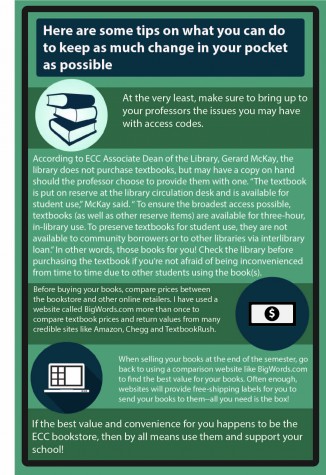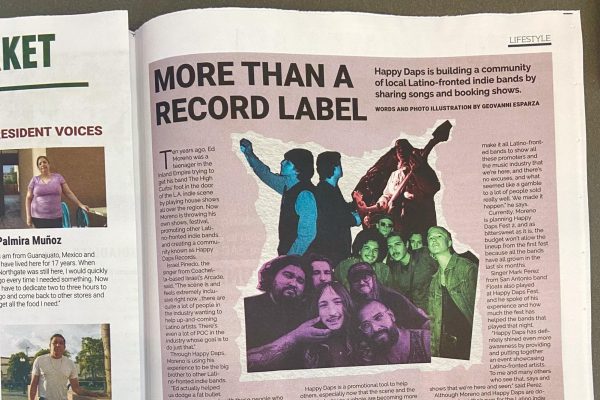Turning Pages: Uncovering the Answers Behind Textbooks
February 28, 2016
 Many of Elgin Community College’s students have felt like they have been cheated when it comes to the purchasing and returning of their textbooks.
Many of Elgin Community College’s students have felt like they have been cheated when it comes to the purchasing and returning of their textbooks.
Students have felt frustrated with such issues like textbook prices, return values and access codes, and simply don’t know what to do about it.
In this article, I will be discussing the general processes the bookstore goes through to get textbooks from the publisher to you, how these processes affect you, the student, and what you can do to combat some of the frustrations you may have.
I became interested in the “textbook process” when I purchased my books for the Fall, 2015 semester for a little over $780, and received $45 back for one of my books, while the others I could “donate” back for a quarter, or up to a dollar depending on the book.
How could this possibly be the case? Was I being schemed with books that I was forced to buy for a class, or was it simply a highly unfortunate circumstance?
To find out more about the entire process, I talked with ECC’s Senior Director of Retail Operations, Kelly Strossner.
According to Strossner, ECC’s bookstore operates as its own business separate from ECC, and thus receives no funding from ECC. However, nine percent of the profits from the bookstore go to ECC and are used by the Board of Trustees.
This money is typically used for programs such as the Early Childhood Lab School and continuing education programs.
Concerning the actual price for textbooks, the publishers make the defining price and market retail value while the bookstore marks up the price just enough to make a reasonable profit to both remain in business and support ECC programs with the nine percent it gives back.
The bookstore has even reverted to volunteer work to save costs.
According to a previous interview with Kelly Strossner by the Chicago Tribune in August of 2015, “in Fiscal Year 2014 the college’s business and finance department reports, the store had operating revenues of $4,595,902 and made a profit of $550,763.”
For every dollar the bookstore makes on textbooks, 77.4 cents is for textbook wholesale cost, 10.7 cents goes to college store personnel, 7.2 cents goes towards college store operations, 1 cent is for freight expenses, and 3.7 cents (before tax) is the bookstore’s income, according to a pamphlet called “Why Do My Textbooks Cost So Much?!” that can be picked up at the bookstore.
Further information provided by the same pamphlet explains that publishers like Pearson Education, Cengage Learning and McGraw-Hill Education have their textbooks at such high prices due to the fact that specific textbooks are specialized for a small, niche audience, and that textbooks “require considerably more time and effort to develop.”
As it stands, it does not appear that price is a factor that the bookstore can dramatically change, and it has been taking measures to attempt to bring the costs down as much as it can while still retaining a reasonable profit.
Since price is such a significant factor, further research would have to be done to understand why certain textbooks can cost sometimes up to $300 new while others can be as low as $20 new.
In terms of returns and why I received quarters and dollars for several-hundred dollar textbooks at the end of my Fall, 2015 semester, Strossner claims that this “donation” process occurs because the bookstore “will not be able to sell the book in the following semester.”
Since professors choose what books they want for their classes, the bookstore, as well as the student’s wallet, is at the mercy of the professors and their decisions.
Donations become an option when the professor no longer want that specific book for their classes and the bookstore can not afford to lose money on that book, and are attempting to keep in competition with the likes of Amazon and Chegg.
Some students’ main concern is with the mandatory access codes that come packaged with some textbooks.
These access codes allow a student to log in to an online student account through the publisher to have access to study materials, quizzes and tests, and occasionally an online version of the textbook.
This is another vital situation where the student’s wallet is severely in the hands of their professor.
Fourth semester ECC student, Jenna Steele recounted her experience buying textbooks.
“After spending all this money on overpriced books, it’s honestly stunning how little you get back,” Steele said. “I had to pay about $200 for a book and then an additional $100 for the access code, which is completely absurd.”
Many students, like Steele and myself, are completely fed up with access codes.
The argument can be made that they are convenient and allow for supplemental learning tools, quizzes and the like to be available to the student.
However, the argument becomes invalid when the students don’t want them.
Access codes do provide convenience, but that is the extent of what they provide in my own opinion; on the other end of the spectrum, they drive textbook costs to astronomical heights, prevent the return and buyback of the textbooks because they come shrink-wrapped with the book and occasionally the professors will either sparingly use the access codes or disregard them altogether, only caring about the information in the book itself.
With the great convenience and more extensive use of ECC’s Desire2Learn website, I personally find access codes to be a complete waste of time and money for students and the bookstore.
With this in mind, I would strongly encourage all professors to take great care and consideration when choosing what textbooks they wish to use, since it affects the student body far more than they may realize.
Further research may be done to discern why some professors use access codes while others do not, however that information is also subjective to each individual professor and class.
For more information on the bookstore’s textbook prices, return values and return policy, visit the bookstore and pick up a copy of the two pamphlets “Why Do My Textbooks Cost So Much?!” and “Why Aren’t My Used Books Worth More?” and visit elgin.edu/bookstore.
With all things considered, my situation of receiving $45 back on a $780 purchase was simply an incredibly unfortunate circumstance with many different factors playing off of each other at once, but I believe that more can be done to make the student’s experience with books as good as it can be.




